Back in the day, Southern California was a massive orange grove punctuated by an occasional movie studio.
The region’s soil, temperature, and sunshine were a citrus grower’s dream. Grateful Californians named a city and later an entire county after the beloved fruit.
The groves have long since been replaced by housing developments, traffic jams, and cracked asphalt. But you can still enjoy fresh oranges straight off the tree in your SoCal backyard.
Origins of the Orange Tree
The sweet orange (Citrus sinensis) has its roots in Southeast Asia, with wild varieties originating in areas like China and India.
Over the centuries, oranges spread westward, reaching Europe via trade routes and later sailing across the Atlantic with Spanish explorers. They were introduced to California in the mid-19th century.
California’s Mediterranean climate proved ideal for orange cultivation, and by the late 1800s, the fruit was a centerpiece of Southern California agriculture.

Keep gardening, my friends, and one day this can be the view through your patio door.
Popular Orange Varieties for Southern California
These are some of the best varieties to cultivate in SoCal, along with their key characteristics:
Washington Navel
Sweet and seedless with easy-to-peel skin, this orange was made for your fruit bowl.
- Tree Size: Medium (8–10 feet tall in home gardens)
- Time to Harvest: Winter (November–January)
Valencia
Valencia is one of the best varieties for fresh-squeezed orange juice.
- Tree Size: Larger (10–15 feet tall in home gardens)
- Time to Harvest: Late spring to mid-summer (April–July)
Cara Cara Navel
A lower-acid variety with striking pink flesh.
- Tree Size: Medium (8–10 feet tall)
- Time to Harvest: Winter (December–April)
Blood Orange (Moro)
Famous for its bright red flesh and tangy, berry-like flavor.
- Tree Size: Small to Medium (6–12 feet tall)
- Time to Harvest: Late winter to early spring
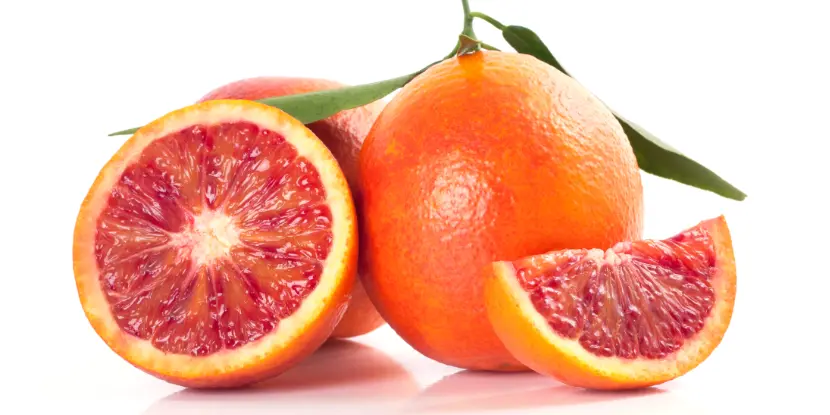
Blood oranges have striking red flesh and tangy, berry-like flavor.
Optimal Growing Conditions
Light
- Orange trees need full sun at least 6–8 hours daily to grow and fruit.
- Plant them where they won’t be shaded by buildings or trees.
Temperature
- Oranges flourish in temperatures between 55°F and 85°F.
- Most varieties can tolerate brief frosts, but prolonged exposure below 29°F may damage the fruit and tree.
Soil
- Well-draining soil is a must. Sandy loam soil is ideal, but if your garden has clay-heavy soil, amend it with compost or sand to improve drainage.
- Aim for a slightly acidic to neutral pH level (6.0–7.0).
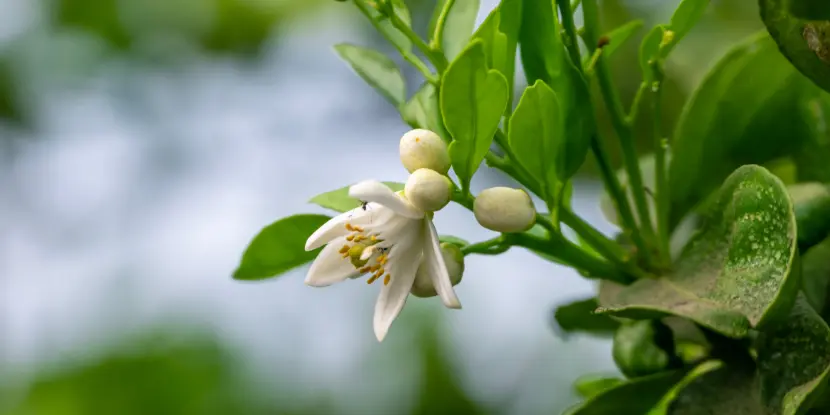
Closeup of the delicate flowers of a Navel orange tree.
Propagating an Orange Tree
While most gardeners buy grafted orange trees from nurseries, it’s possible to propagate your own from seeds or cuttings.
From Seeds
It’s a fun project, but seed-grown oranges take 7–15 years to produce fruit and may not grow true to their parent variety.
From Cuttings
- Select semi-hardwood cuttings from a healthy tree.
- Dip the cut end in rooting hormone and plant it in a pot.
- Water regularly and keep the cutting warm until roots develop.
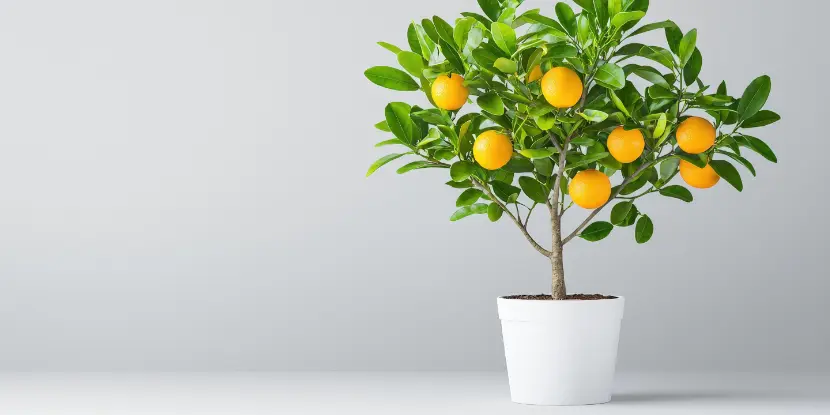
Orange trees can be grown in pots, as long as the container has good drainage and can accommodate the plant’s roots.
Planting an Orange Tree
Planting in the Ground
- Choose a sunny spot with at least 6–8 hours of daily sun.
- Dig a hole twice as wide as the root ball but no deeper. Amending the soil with compost helps improve drainage.
- Position the tree so the top of the root ball is slightly above ground level. Backfill the hole gently without overpacking the soil.
- Water the soil thoroughly immediately after planting.
- Spread organic mulch around the base, leaving a few inches clear of the trunk to prevent rot.
Planting in a Pot
- Use a large pot with drainage holes (at least 16–18 inches wide and deep).
- Fill the pot with a well-draining potting mix designed for citrus trees.
- Plant as you would in the ground, ensuring the root ball is at the correct height.
- Place the pot in a location with full sun.
- Water thoroughly and ensure excess water drains out.
Orange Tree Care
Water
Orange trees love consistent moisture but dislike soggy soil.
- Young trees: Water 2–3 times a week until established.
- Mature trees: Water deeply once a week, soaking the top 12–18 inches of soil.
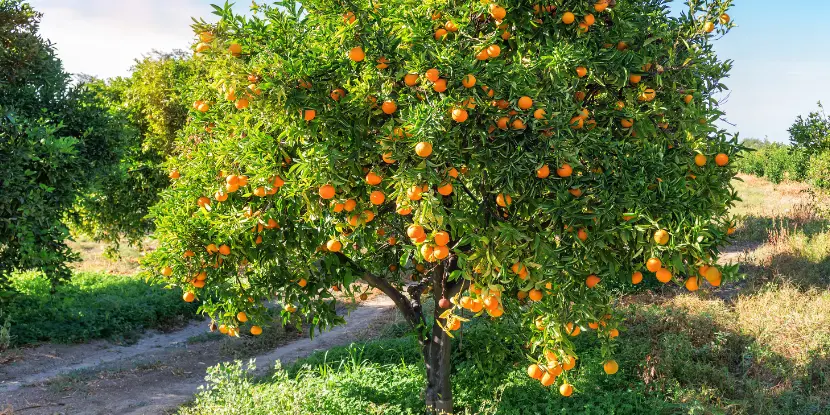
An orange tree grows by a dirt road in an orchard.
Fertilizer
Use a citrus-specific fertilizer rich in nitrogen.
- Young trees: Every 6 weeks during the growing season.
- Mature trees: 3–4 times per year (spring, summer, fall).
Pests & Diseases
- Pests: Look out for aphids, scale, and whiteflies. Use insecticidal soap or neem oil to manage infestations.
- Diseases: Citrus trees are vulnerable to citrus canker and root rot. Ensure proper drainage and remove infected branches.
Pruning
- Prune in late winter or early spring to remove dead or crowded branches.
- Clear the lower 12–18 inches of growth to allow airflow and prevent pests.
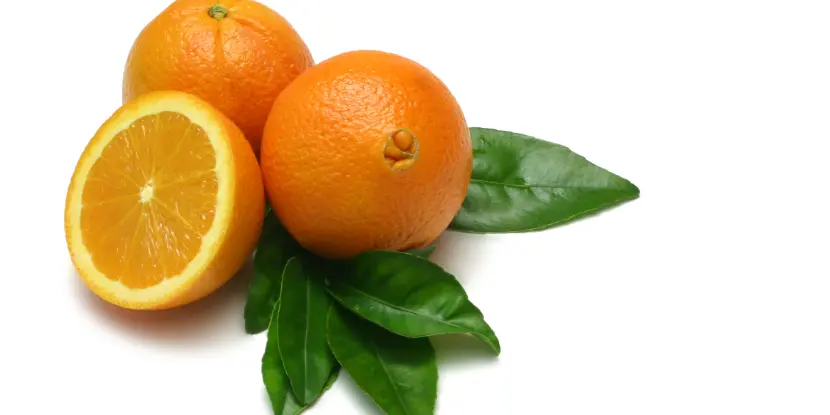
The orange juice in your fridge probably came from Valencia oranges.
Harvesting Oranges
Oranges don’t continue to ripen off the tree, so timing is everything. Harvest them when:
- The skin is fully colored.
- The fruit feels heavy.
- Taste tests confirm sweetness!
Gently twist the fruit or clip it off with pruning shears.
FAQs: Orange Tree Care
Q: How long does it take for orange trees to bear fruit?
Grafted trees typically fruit within 2–3 years. Seed-grown trees may take 7–15 years.
Q: Can I grow orange trees indoors?
Yes, but they need bright light and should only be grown indoors in frost-prone areas.
Q: How can I protect my tree from frost?
Cover young trees with frost cloth, and mulch heavily around the base to insulate the roots.
Q: Why are my orange tree’s leaves yellowing?
This may indicate a lack of nutrients, overwatering, or poor drainage.
Q: What’s the best pot size for an orange tree?
Start with a pot at least 16–18 inches wide and deep, and upgrade as the tree grows.
Q: Can I grow multiple varieties in one garden?
Yes — just space them at least 10–15 feet apart.
Q: When is the best time to plant orange trees?
Late winter to early spring is ideal for planting.
Q: How can I encourage more fruit production?
Consistent feeding, watering, and pruning will maximize fruiting.

